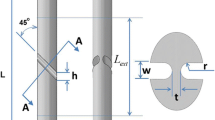Abstract
The qualitative dependence of the mechanical behavior of some materials on strain rate is now well known. But the quantitative relation between stress, strain and strain rate has been established for only a few materials and for only a limited range. This relation, the so-called constitutive equation, must be known before plasticity or plastic-wave-propagation theory can be used to predict the stress or strain distribution in parts subjected to impact stresses above the yield strength.
In this paper, a brief review of some of the experimental techniques for measuring the stress, strain, strain-rate relationship is given, and some of the difficulties and shortcomings pointed out. Ordinary creep or tensile tests can be used at plastic-strain rates from 10−8 to about 10−1/sec. Special quasi-static tests, in which the stress- and strain-measuring devices as well as the specimen geometry and support have been optimized, are capable of giving accurate results to strain rates of about 102/sec. At higher strain rates, it is shown that wave-propagation effects must be included in the design and analysis of the experiments. Special testing machines for measuring stress, strain and strain-rate relationships in compression, tension and shear at strain rates up to 105/sec are described, and some of the results presented. With this type of testing machine, the analysis of the data requires certain assumptions whose validity depends upon proper design of the equipment. A critical evaluation of the accuracy of these types of tests is presented.
Similar content being viewed by others
References
Krafft, V. M., “Instrumentation for High-Speed Strain Measurements,”Response of Metals to High Velocity Deformation, 9 Interscience, New York (1961).
Kolsky, H., “Stress Waves in Solids, Oxford University Press, London (1953).
Hauser, F. E., Simmons, J. A., andDorn, J. E., “Strain Rate Effects in Plastic Wave Propagation,”Response of Metals to High Velocity Deformation, 93, Interscience, New York (1961).
Rajnak, S. L., andHauser, F. E., “Plastic Wave Propagation in Rods,” Symp. Dynamic Behavior of Matls. ASTM Special Publ. No.336, 167 (1962).
Larsen, T. L., Rajnak, S. L., Hauser, F. E., andDorn, J. E., “Plastic Stress/Strain Rate/Temperature Relations in H.C.P. Ag-Al Under Impact Loading,”Jnl. Mech. Phys. Solids,12,301 (1964).
Chiddister, J. L., andMalvern, L. E., “Co Noression-impact Testing of Al at Elevated Temperatures,”Experimenta Mechanics,3 (4),81 (1963).
Ripperger, E. A., andYeakley, L. M., “Masurement of Particle Velocities Associated with Waves Propagating in Bars,”Ibid. (2),47 (1963).
Malvern, L. E., and Efron, L., “Longitudinal Plastic Wave Propagation in Annealed Aluminum Bars,” Tech. Rpt. No. 1, NSF Grant G-24898, Michigan State Univ. (1964).
Author information
Authors and Affiliations
Rights and permissions
About this article
Cite this article
Hauser, F.E. Techniques for measuring stress-strain relations at high strain rates. Experimental Mechanics 6, 395–402 (1966). https://doi.org/10.1007/BF02326284
Issue Date:
DOI: https://doi.org/10.1007/BF02326284




